5 Simple Dumbbell Exercises: Full Body Beginner Workout
Boost your strength and energy with these five simple dumbbell exercises. A full-body workout routine designed to enhance your overall physical and mental well-being.
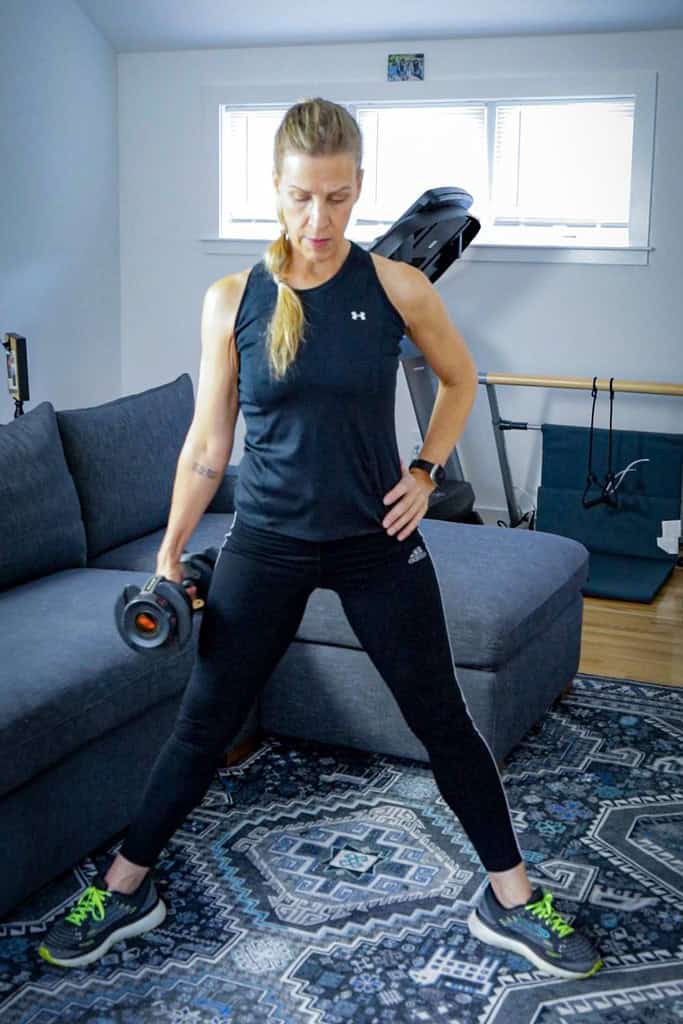
Prioritize your health with these five simple dumbbell exercises. Designed to be a time-efficient, energy-boosting, full-body dumbbell workout routine.
It can be challenging to find time to exercise daily, especially as a busy caregiver when we are taking care of others and our loved ones.
Going to the gym, although at times can be a nice respite, can be even more challenging because it requires more time. Plus gym memberships can be very pricey.
For me, working out is one of my main stress relievers. I know that is not the case for everyone, and I think my passion for exercise has a lot to do with my background as a gymnast, professional dancer, and certified personal trainer. I have been physically active for the majority of my life.
Because my body is now accustomed to the physical stressors and demands of exercise, when I am not in a regular routine, not only do I feel it physically but my mental health suffers as well.
Let me show you some simple, basic, free-weight exercises that will help you build muscle strength and reduce stress, all in the comfort of your own home.
These beginner dumbbell exercises are quick, effective and provide you with an excellent workout. You will get the hang of it in no time.
This article may contain affiliate links for your convenience, and as an Amazon Associate, I earn from qualifying purchases at no extra cost to you. You can read the full disclosure policy here.
Equipment and Preparation For Your First Beginner Dumbbell Workout
Before starting your first beginner dumbbell workout, it is important to consult with your primary doctor or other health professional to let them know your plans and to get their medical advice if needed.
This is always a good idea when starting something new, especially when placing demands on your body that it hasn’t faced before.
Next, it is essential to have the right equipment and to prepare a safe space to exercise.
A simple set of dumbbells is a great place to begin, as it allows you to focus on proper form and building strength without feeling overwhelmed with heavy weights.
If you want more flexibility, consider investing in a pair of adjustable dumbbells, which can be adjusted from light to heavy weight as you progress. Adjustable weights are what I use and I love them. I’ll be honest, they are not cheap, but for me, they were worth the investment. I have owned mine for almost ten years now, and have had zero problems.
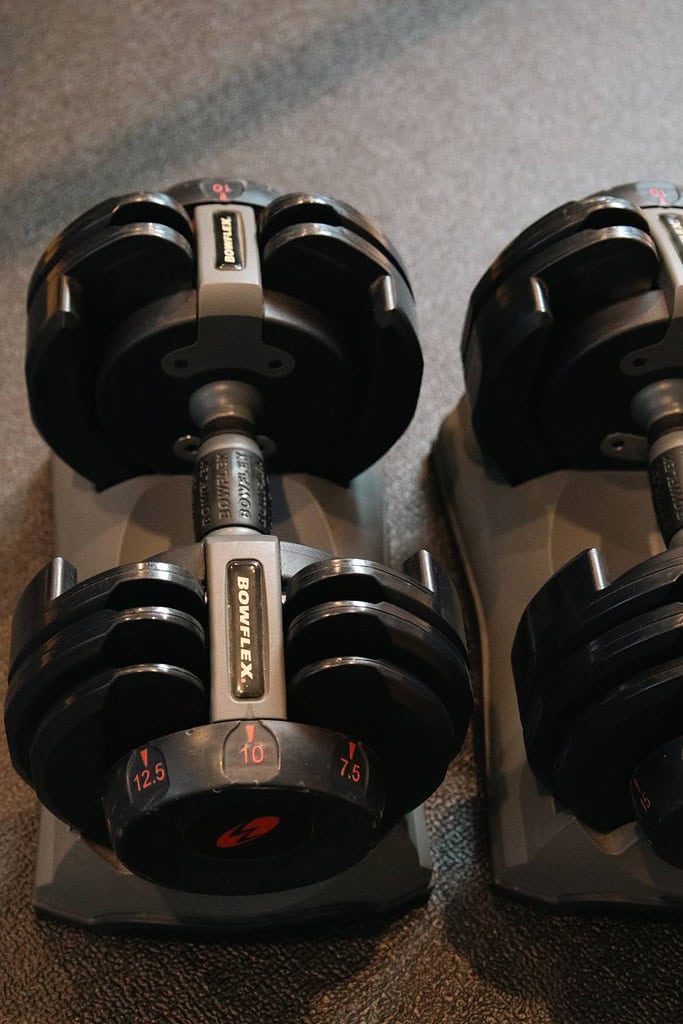
For most exercises, however, a pair of dumbbells that you can comfortably handle is all you need.
Your living room, or any large area, can easily serve as your workout space. Just clear an area large enough so that you have enough room to move safely.
With the right set of dumbbells and a prepared space, you are ready to start your fitness journey.
5 Simple Dumbbell Exercises For Beginners
Before I start talking about the actual exercises, I want to mention that all movements are considered compound movements, meaning each exercise will work more than one muscle group at a time.
The best thing about doing compound exercises is that it is a great way to achieve a full-body workout in a short amount of time. That said, it becomes even more important to use correct posture and form. I discuss details of proper form after each exercise.
1. Sumo Squat to Overhead Press (legs and shoulders)
GOAL. The Sumo squat is a variation of the classic squat, and its goal is to work the inner thighs, glutes, and quadriceps. The overhead press targets primarily the shoulders but will also get to the triceps and upper chest. Put these two dumbbell exercises together for a strong compound move.
STEP-BY-STEP
- Start with your feet slightly wider than shoulder-width apart, and with your toes pointed out about 45 degrees. Hold the dumbbells together between your legs, and stand up tall by engaging your core – your stomach and back muscles.
- Bend your knees while holding your upper body straight, ensuring your knees stay directly over your toes. Go down as far as you can comfortably while maintaining proper form.
- Press up through your heels, straightening your legs to return to your starting position, while also bringing your weights up to shoulder height with your palms facing forward.
- From this position, press the weights up over your head until your arms are fully extended and straight. Keep your core engaged and avoid arching your back.
- Lower the dumbbells back down to your shoulders and then between your legs.
Repeat this for 10-12 repetitions.
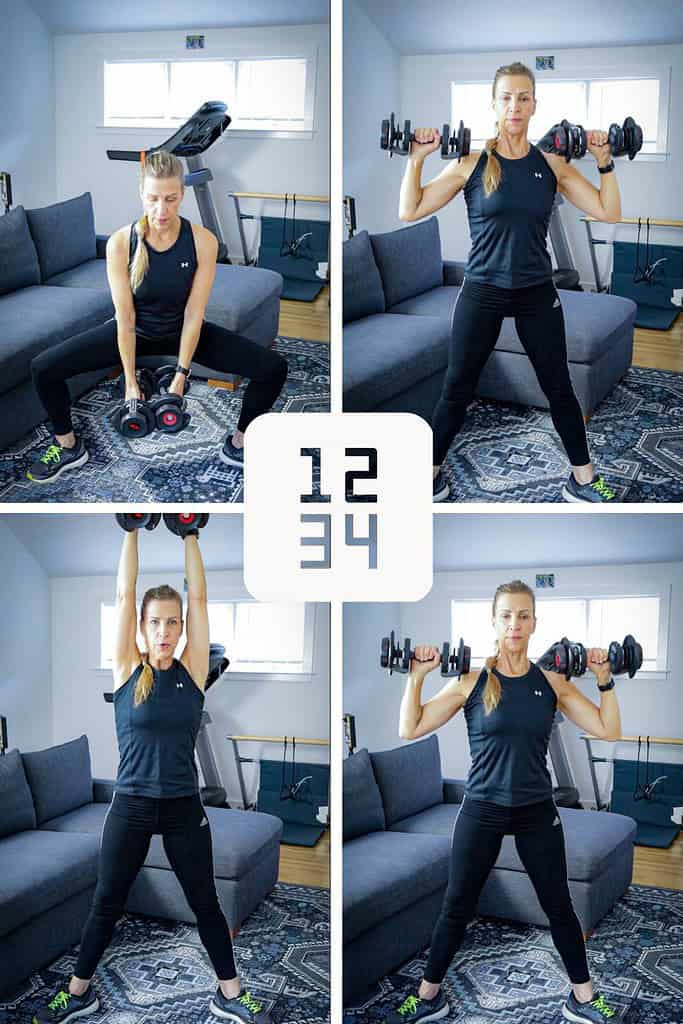
Technique. It is important to always keep your core strong and engaged. Do not sag in the back and shoulders, keep your chest lifted, and your shoulders relaxed. Also, be careful of locking your knees at the top of the squat to protect your joints.
2. Sumo Crossover Squat to Bent-Over Row (legs and back)
GOAL. The Sumo squat is a variation of the classic squat, and its goal is to work the inner thighs, glutes, and quadriceps. The bent-over row targets primarily the upper and lower back but will also get the shoulders and biceps.
STEP-BY-STEP
- Start with your feet slightly wider than shoulder-width apart, and with your toes pointed out about 45 degrees. Hold one dumbbell in your right hand by your side, and stand up tall by engaging your core – your stomach and back muscles.
- Bend your knees while hinging forward and to the left, and cross your right arm over as if you are going to have the dumbbell touch your left foot.
NOTE: At this point, more weight will be on your left bent leg than your right. Let the right arm and dumbbell hang down with your arm fully extended. Do not actually touch your foot. - Pause in this forward crossed position, then pull the right dumbbell back toward your torso, squeezing your shoulder blades together at the top.
- Lower the weight back down toward your left foot, and then carefully press up through both heels to straighten the leg back to your starting position with your arm straight holding the weight by your side.
- Repeat this same compound move on the other side – knees bend while body hinges forward, left arm crosses over to right foot, pull the dumbbell back toward torso, bring the weight back down toward right foot, and then stand.
Repeat this for 10-12 repetitions.
NOTE: You can do 10-12 repetitions on one side and then switch sides, or you can alternate every repetition as you go.
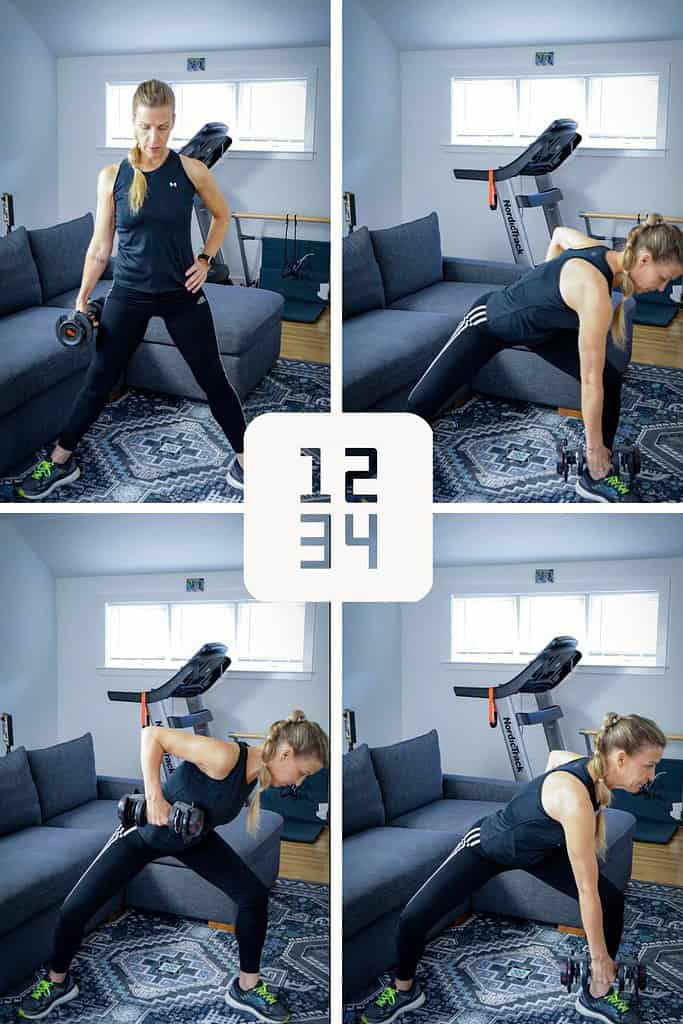
Technique. It is important to keep your core strong and engaged during this entire movement, and your torso parallel to the floor as best you can during the bent-over row. At the top of the row, really squeeze your shoulder blades together to feel your back working. Work through the entire exercise smoothly and with control. No jerky, uncontrolled movements.
Work on these two dumbbell exercises separately if you wish, to get the hang of each movement before putting them together.
3. Lunge to Tricep Extension (legs and triceps)
GOAL. A regular lunge is an overall lower-body exercise that works the entire leg – quadriceps, hamstring, and glutes. A tricep extension is the opposite. It is an isolation exercise that targets the triceps, which are the three muscles on the back of your upper arm. When you put these two dumbbell exercises together, you have a powerful combination.
STEP-BY-STEP
These two exercises are going to be done at the same time. While you are lunging, you are also doing the tricep extension.
- Legs: Start with your feet hip-width apart. Take one big step forward and position your body with your hips square, back heel off the ground, torso upright, and your core engaged. This is the starting position with your legs.
- Arms: Now, hold one dumbbell with both hands directly above your head with your arms fully extended. Keep your elbows turned in, and tight toward your ears. This is the starting position for your arms.
- Legs: Bend both knees as close to a 90-degree angle as you can. Your front knee should be directly above your ankle, not in front of it, and your back knee should be just above the floor, do not touch or rest your knee on the floor.
- Arms: Lower the dumbbell slowly behind your head by bending your elbows, still keeping them near your ears, and keeping your upper arms stable. Just your lower arms are moving.
- Legs: Push through your front heel and return to the starting position.
- Arms: Once your forearms are parallel to the floor, press the dumbbell back up to the starting position by straightening your arms.
Repeat this exercise for 8-10 repetitions before switching over to do the other leg.
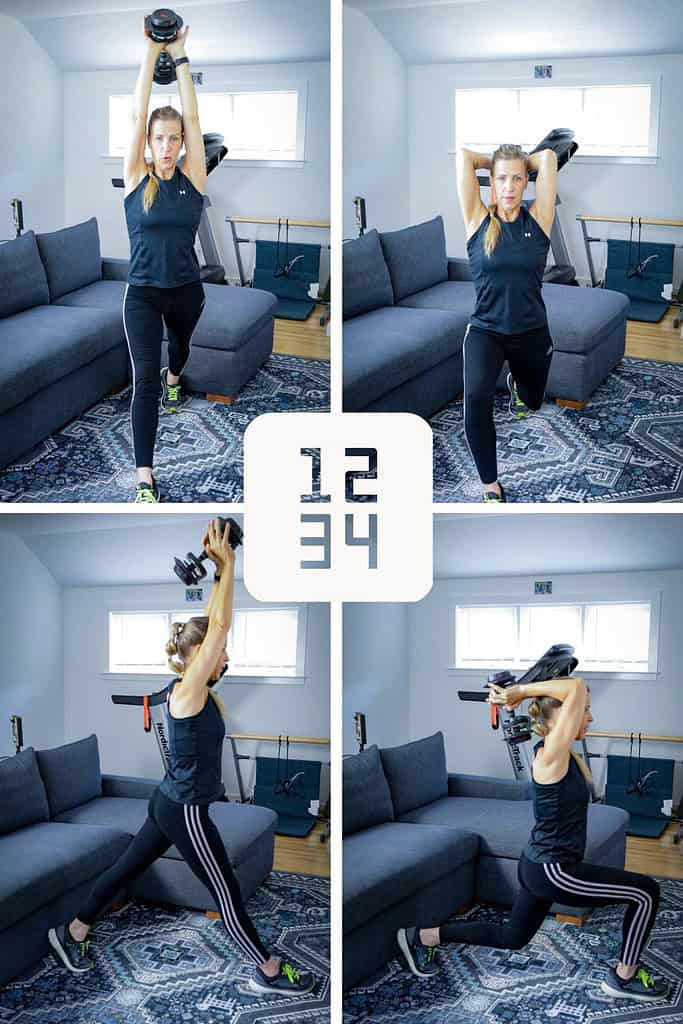
Technique. Lunges are not an easy exercise so it is very important to maintain strict form and technique. The main thing to remember is to keep your front knee directly above your ankle. Do not let it go past or to the right or left of your ankle. This can be hard on the joints. Really engage your core and do not look down while you are doing the exercise. If bending your knee to 90 degrees is too hard, just bend it to a 45-degree angle instead to get started.
For the tricep extension, keep your elbows locked tightly by your ears as best you can, and try not to let them rotate out too far. This isolates the tricep muscles and, if done right, it burns!
4. Classic Squat to Bicep Curl (legs and biceps)
GOAL. The classic squat is a foundational lower-body exercise that primarily works the quadriceps, hamstrings, and glutes. While the bicep curl targets the two muscles in the front of your upper arm. Doing these two dumbbell exercises together will work the full body.
STEP-BY-STEP
- Stand with your feet should-width apart and with your toes turned out just slightly. Hold the weights in your hands, arms straight and at your side.
- Slowly bend your knees and move your hips and glutes back, as if you are going to sit in a chair. Sit back and down until your thighs are almost parallel to the floor while keeping your knees directly over your toes. Let your arms holding the weights move down toward the floor as you bend your knees.
- Press into your heels and return to your starting position, standing straight and tall, core engaged with weights at your side.
- Next, while holding your dumbbells, turn your palms up, hold your elbows in tight at your sides, and slowly curl the dumbbell up by bending your elbows, making your lower arm the only thing that moves.
- Once the dumbbell reaches shoulder height, without resting there at the top, slowly lower your arms back to your side and starting position.
Repeat this compound movement for 10-12 repetitions.
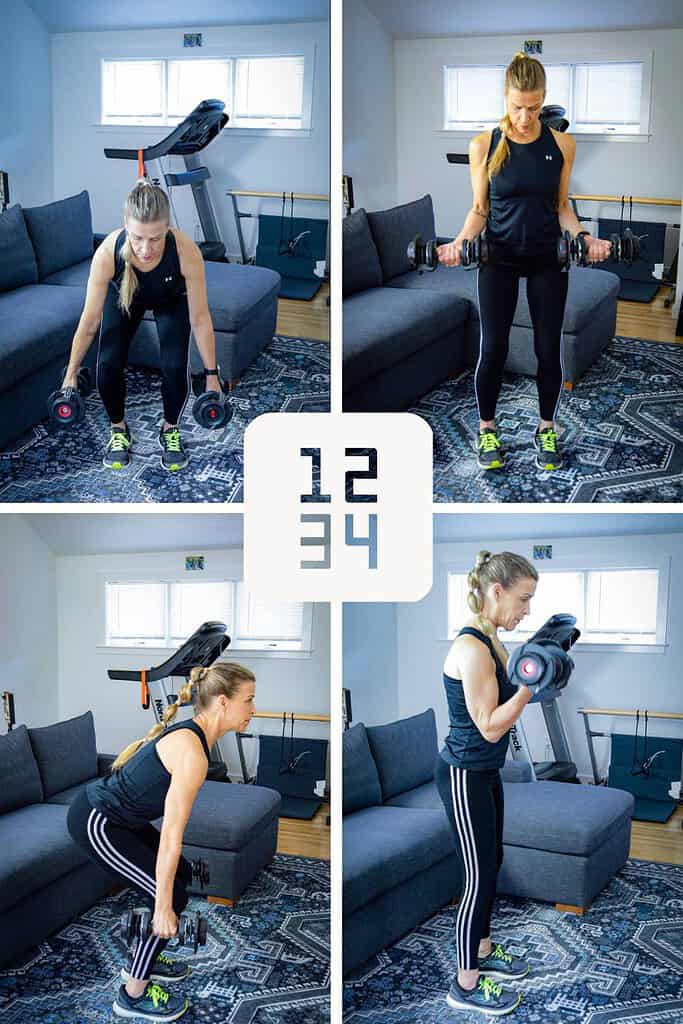
Technique. When you perform a classic squat, you want to make sure your knees remain over your feet and not push too far forward and beyond. This will protect your knees, and keep the majority of the weight in your muscles versus pressure on your joints.
It is also important to keep your back flat while doing a squat, do not round your back and look down. Look out comfortably and engage your core.
With a dumbbell bicep curl, keep those elbows tucked close to your body, move only your forearm and hands, and maintain controlled movements. You do not want to swing your curl up. Slow down and control your movements.
5. Floor Press to Knee Raise (chest and abs)
GOAL. The floor chest press primarily works the pectoral muscles but it also works the shoulders and triceps. While the knee raises target the lower abdominal muscles.
STEP-BY-STEP
- Lie on your back with your knees bent and your feet planted firmly on the floor. Holding your dumbbells in each hand, bring them up directly above your chest with your arms straight and your palms facing outward, away from your face. Keep your wrists in line with your hands, do not break your wrists, they should be an extension of your hands.
- Slowly bend your elbows and lower the dumbbells until your elbows gently touch the floor. Keep your upper arms and elbows wide, like a reverse push-up.
- Straighten your arms and press the weights back up to the starting position.
- Next, while continuing to hold the weights above your chest in the starting position, press your lower back into the floor and raise your bent knees toward your chest, arms, and weights, using your abdominal muscles.
- Slowly bring your legs back down to the starting position with your knees bent and your feet planted firmly on the floor.
- Continue to keep your core engaged while you repeat this entire sequence.
Repeat this exercise for 10-12 repetitions.
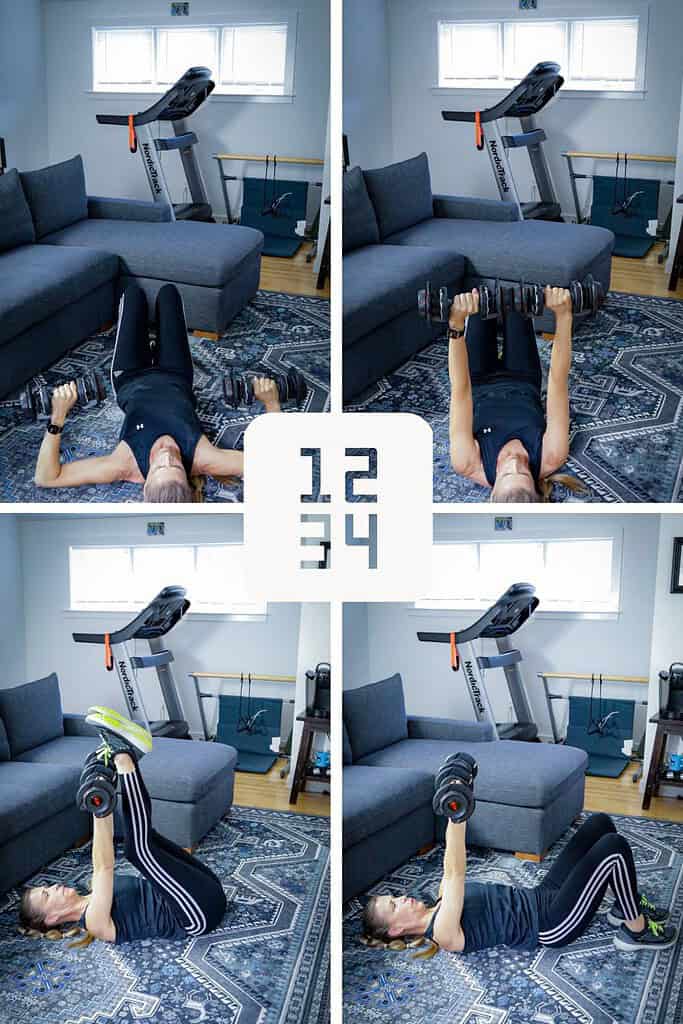
Technique. Keep your back flat and pressed firmly into the floor, and engage your core throughout the entire exercise sequence. When doing the floor press, pop your chest up keep your shoulders back, and push into the floor as best you can. This will help isolate the chest rather than put it all into the shoulders.
Sometimes people have a hard time feeling a chest press in their chest but rather feel it primarily in their shoulders. I always teach people to really exaggerate the move at first so you can better feel the chest muscle working.
If you are having trouble doing the two dumbbell exercises together, separate them and do each of the exercises one at a time, until you can feel the proper muscles working. Then put them together for the compound move.
Strength-Training Tips For Beginners
Lifting weights, using dumbbells, and feeling your body get stronger and stronger can be fun and empowering. There are a few things to keep in mind, however, if you are just starting out.
Start Low
If you are a beginner and new to using weights, I suggest you start with a lighter set of dumbbells, even if they feel perhaps too light, just until you get comfortable with using the correct form and technique.
Go Slow
Make sure all of your movements are slow and controlled. Never swing your dumbbells around half-hazard. If you find you are using momentum to move your weights, then I suggest you go lighter and make your exercise movements very, very controlled. You can gradually increase the weight and repetitions as your strength and form improve.
Warm Up
It is very important to warm up your body before doing any kind of weight training exercises, or any kind of exercise for that matter. Many people skip this step, thinking it’s not necessary, however, skipping warm-up will put you at higher risk for injuries, tears, and strains.
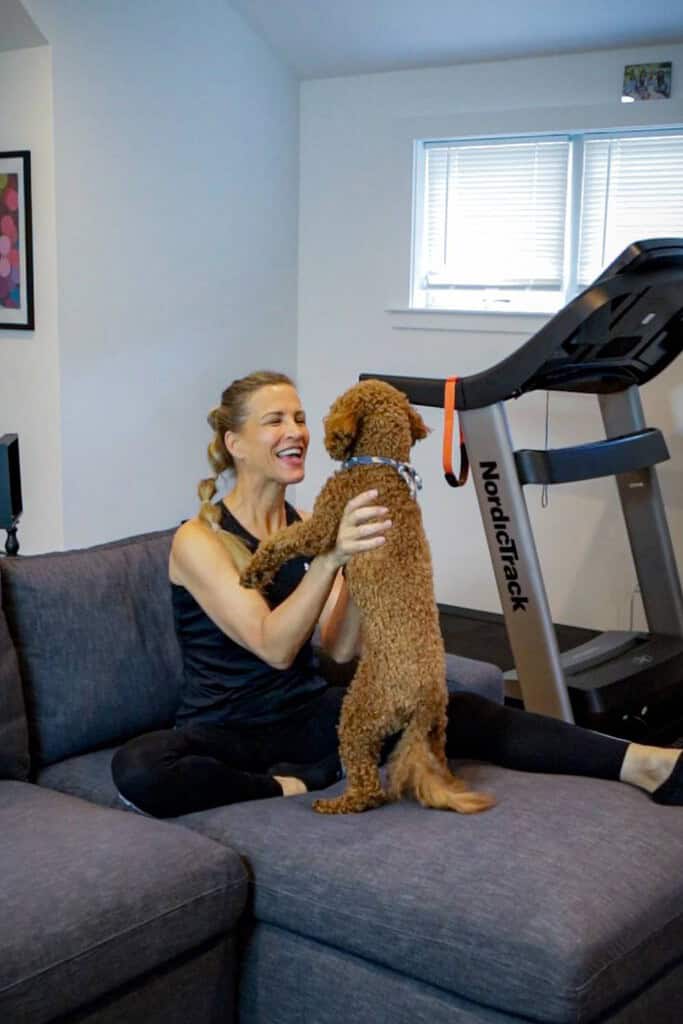
All it takes to get hurt sometimes is one wrong move when our muscles are cold. Take the time to warm up. Be it a short walk and a few stretches, or some jumping jacks, anything to help your body feel warm and more prepared for a heavier-weight workout.
Cool Down
As important as warming up is, so is cooling down. Taking the time to cool down after these five simple dumbbell exercises is important to help reduce muscle stiffness and aid in recovery. It also helps to improve flexibility and reduce the risk of injury as our body cools down.
Hydrate
Hydrate before, during, and after every workout. Staying hydrated is important throughout to keep energy levels consistent, optimize muscle function, and prevent hydration. Drinking adequate amounts of fluid aids in body temperature regulation. and also helps with the process of recovery.
Track Progress
Tracking your progress can be an incredible motivator. Start from the very beginning, track your successes AND your failures. Keep a workout journal, and you will be surprised how quickly you improve if you remain consistent.
Celebrate the big and small victories along the way. You are worth it!
Why Is Strength Training Important?
Strength training is important for everyone, Working out with dumbbells helps improve muscle strength, increase energy levels, and prevent osteoporosis as we age.
It is especially important for caregivers, as we use our bodies and strength to assist those we care for. Strength training supports everyday activities like lifts, transfers, and providing physical support.
Additionally, strength training can help reduce stress, boost circulation, and enhance our overall well-being.
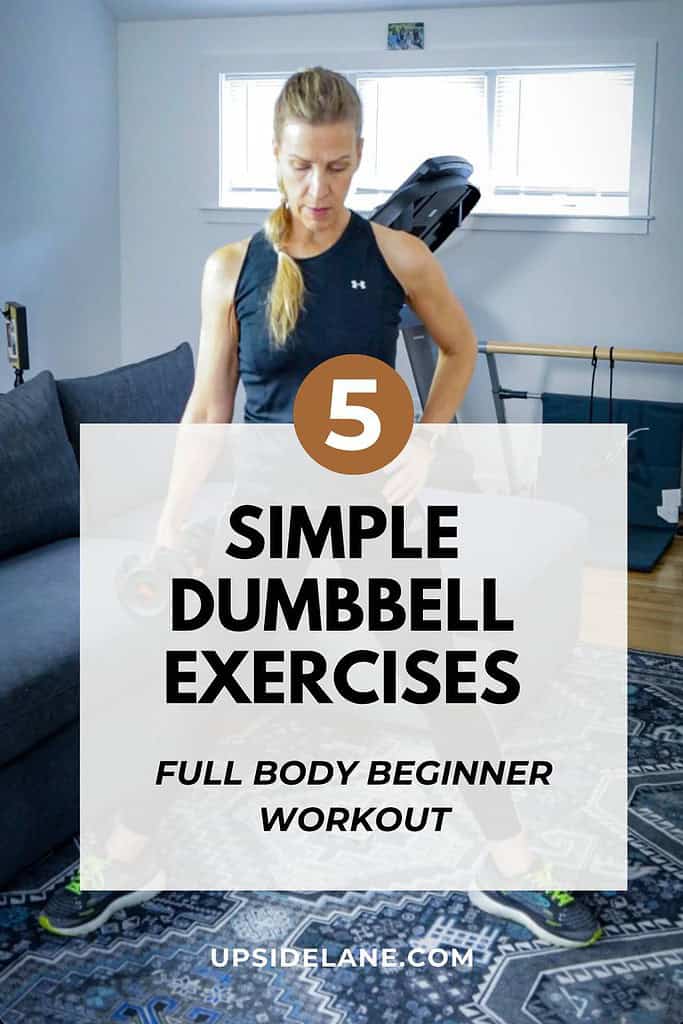
Building Confidence With Dumbbell Exercises
Incorporating simple dumbbell exercises into your daily routine is a simple yet effective way to build strength, improve mood, and enhance your overall health.
Start with the basics, focus on proper form, and gradually increase intensity and repetitions as you progress.
I encourage you to take the time to prioritize your own personal health so that you can better take care of the ones you love. Doing these five simple dumbbell exercises a few times a week will help you maintain your energy and the resilience needed to care for others effectively.
When we invest in our own health and wellness, we not only enhance our own lives but also better support the ones we care for and love. Happy lifting.
If you would like to join the Upside Lane Community for additional support and encouragement, you can sign up below. It is a lovely and supportive community where I provide healthy plant-based recipes, joyful living tips, and caregiver resources directly to your inbox, to help you on your caregiver journey.
More Physical Well-Being Articles
- 5 Simple Tips For Staying Fit As A Busy Caregiver
- My Minimalist Home Gym Setup: A Caregiver Necessity
- Is 10k Steps A Day Active? Easy Examples For Caregivers
- Why I Love Using My Infrared Sauna At Home
Additional Support For Caregiver Health
Let’s Connect
I hope you enjoyed this article about incorporating simple dumbbell exercises into your daily routine.
Staying strong and fit as we age is critical for overall health and longevity, and incorporating resistance and strength training into your workout regimen will help tremendously.
So grab the weights and have fun watching your body get stronger and stronger.
Let me know how you incorporate exercise into your daily life. What are some of your own personal tips and tricks? You can respond in the comment section below, I’d love to hear from you!
Please consider sharing this article with friends and family, or anyone you feel would find it beneficial.







I love these exercises, thank you for sharing! I’m always looking for new ways to workout at home.
You are most welcome. Quick, easy, and effective! 😉
Wow! Adding this to my workout routine! Loved the pictures! Now I can see what each move is supposed to look like!
Oh I’m so glad you found it helpful. Thank you for your support!
Thanks for sharing these simple dumbbell exercises! You have such a great guide with excellent photos. I’m sharing Theis’s with my daughter and pining for later!
Thank you so much! I am glad you found it helpful. Let’s get moving! 😉
I will had to add these into my routine. Thanks for sharing.
You are welcome. Thank YOU.
This is perfect for an at home workout! Thank you for sharing!
Thank you Julie!
Great information! Thanks
You are welcome Kimberly.
I use workout everyday. I haven’t in a few years & would love to get back into it again. However, I have a degenerative nerve disease in May back & I can’t lift anything. Hopefully one day I will. Great tips!